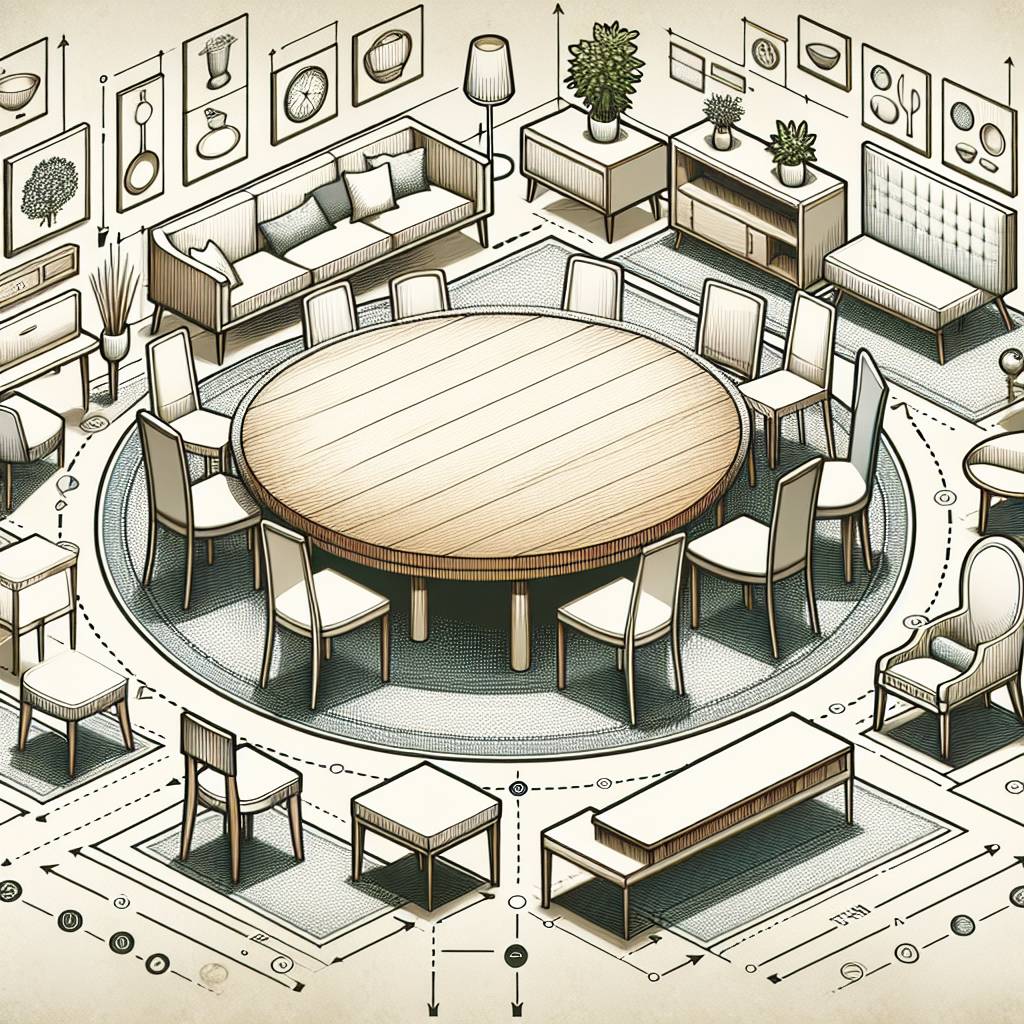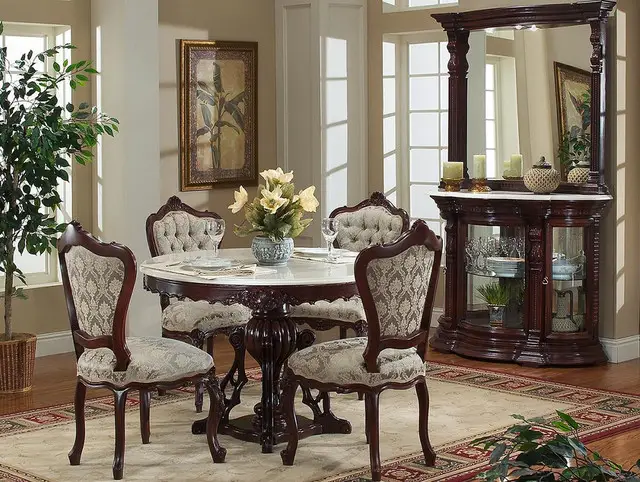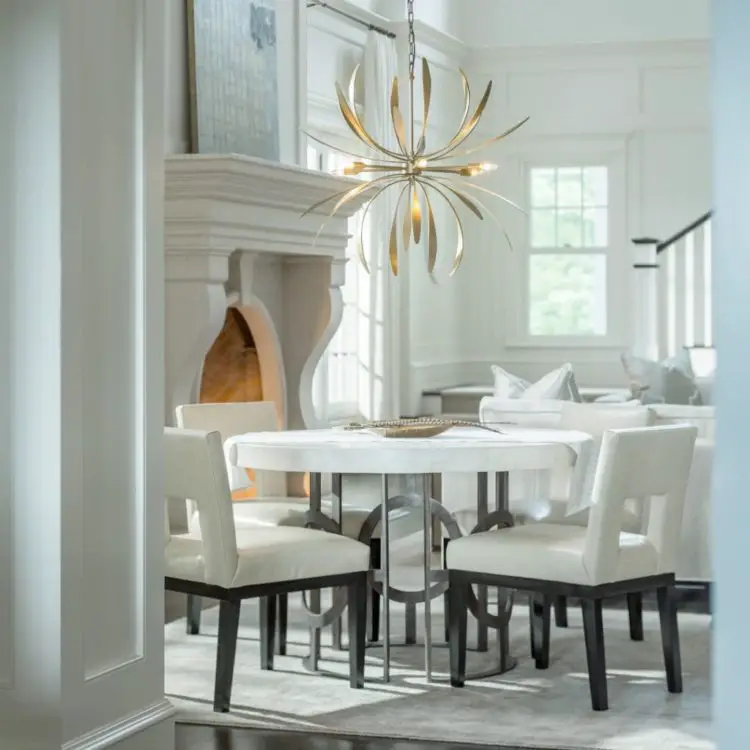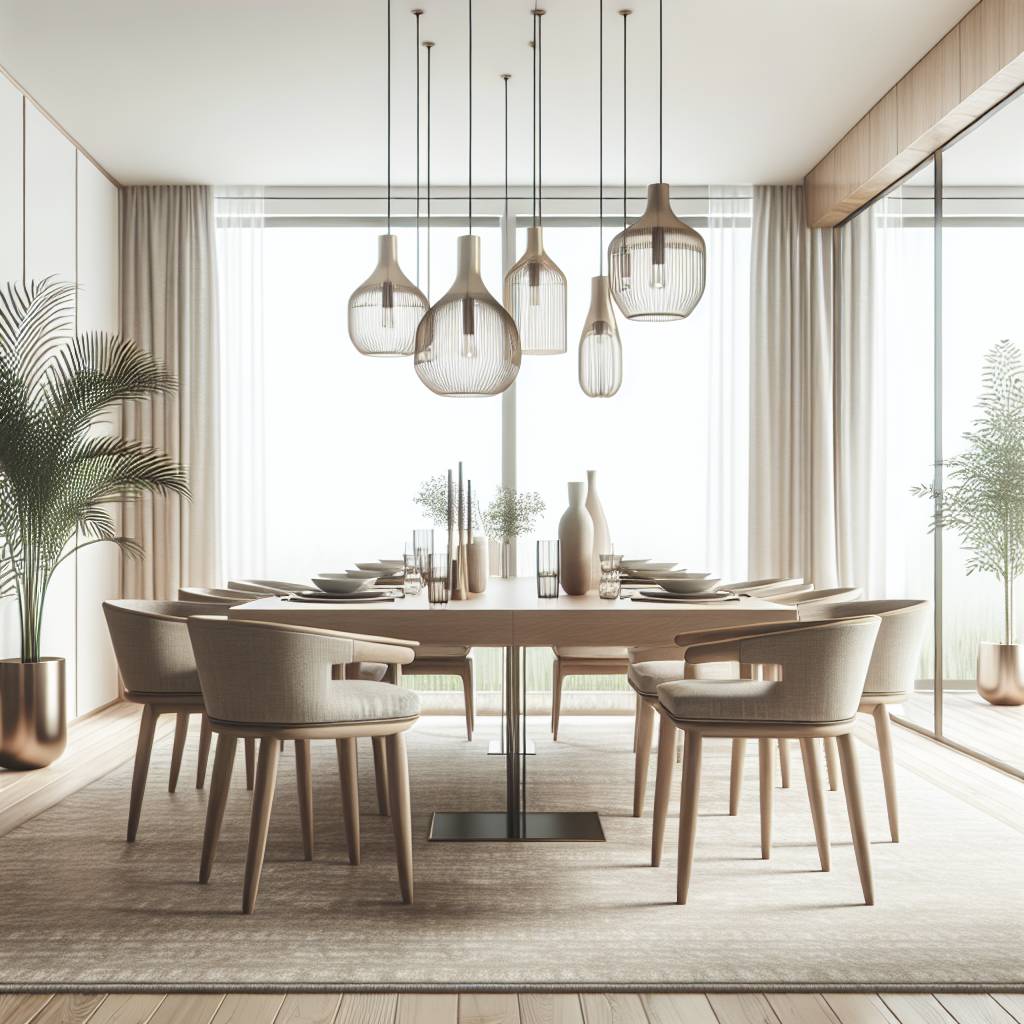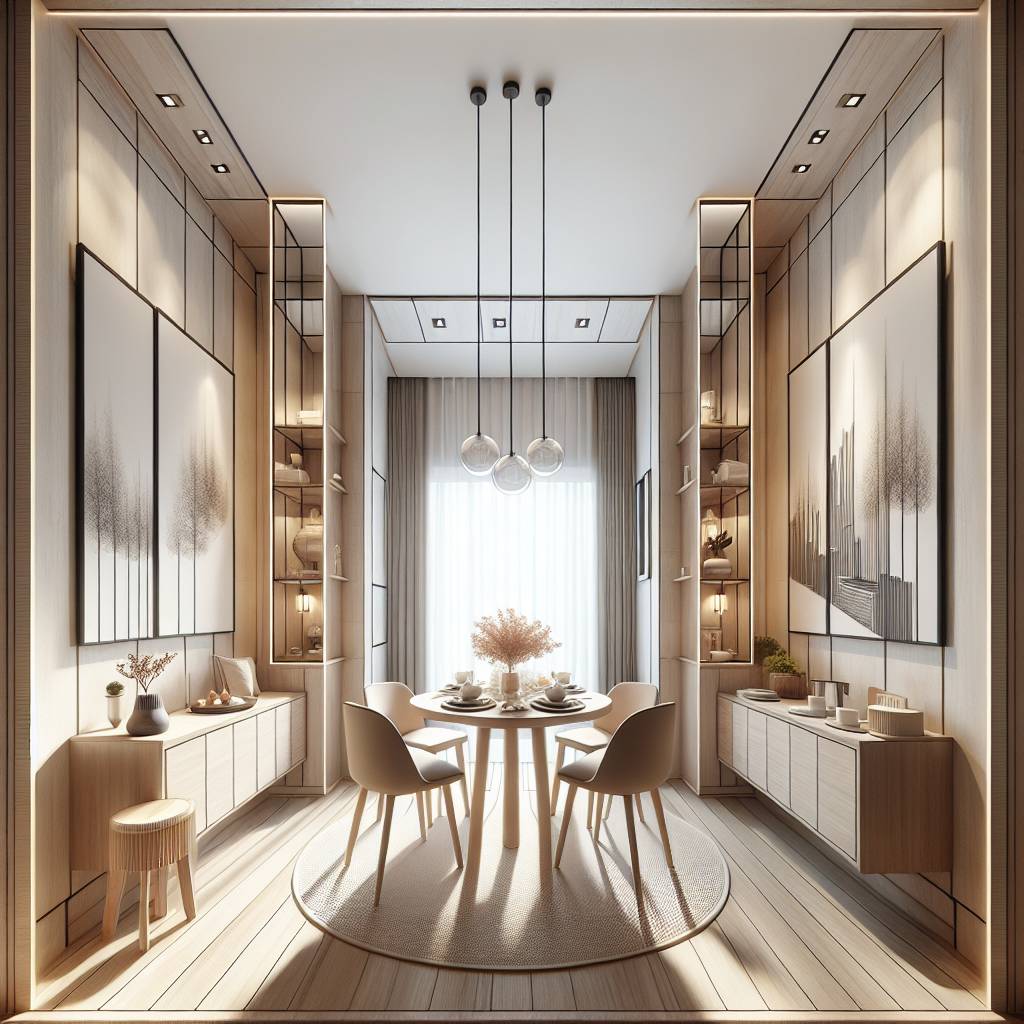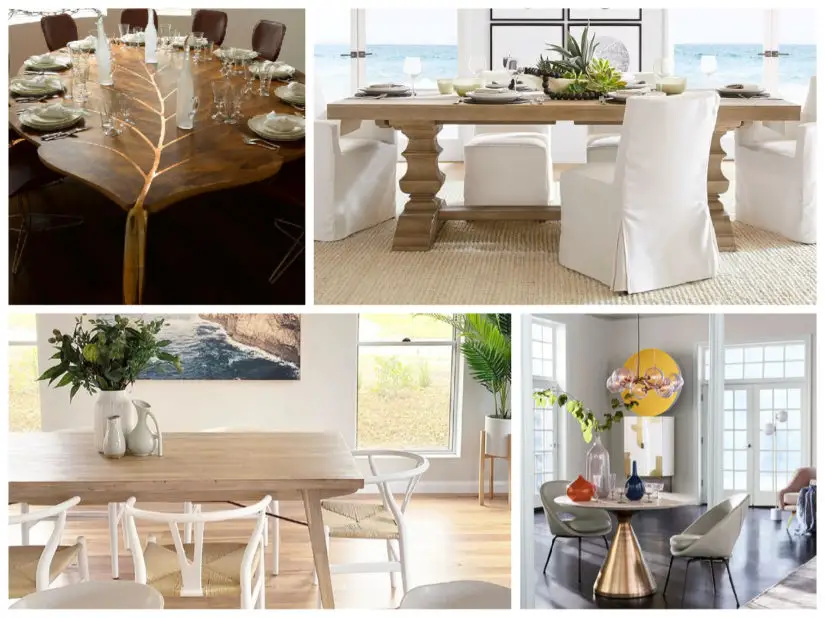Did you know that the shape of your dining table can significantly impact the ambiance and functionality of your dining area? Selecting the perfect dining table shape is crucial for creating a space that suits both your style and lifestyle. From intimate round tables fostering conversation to spacious rectangular ones accommodating large gatherings, each shape offers distinct advantages. Understanding how to choose the right one for your home can transform not just your dining room but also your overall living space. In this post, we’ll delve into practical tips and considerations for selecting the ideal dining table shape that complements your decor while enhancing usability and making the most of your floor space.
Key Takeaways
- Assess your dining space to determine the available area and layout possibilities.
- Consider the standard dining table height to ensure comfortable seating and dining experience.
- Choose the right dining table dimensions based on the number of people you want to accommodate and the available space.
- Explore different dining table shapes such as round, square, rectangular, and oval to find the most suitable option for your space and style.
- Consider the room size and seating needs when selecting a dining table shape to ensure proper flow and functionality within the space.
- Understand the importance of dining table shape in the overall layout and design of your dining area.
Assessing Your Dining Space
Measure Dimensions
When selecting the perfect dining table shape, make sure to start by measuring your dining space. Consider the length and width of the area to ensure the table fits comfortably. This step is crucial, especially for smaller spaces, as it helps prevent overcrowding.
For example, if you have a narrow dining room, opting for a rectangular or oval-shaped table might make more suitable than a round one. These shapes can maximize seating capacity without taking up too much floor space.
Considering the overall layout and flow of your dining area is essential in choosing the right table shape to make. For instance, if your dining room shares an open plan with the kitchen or living room, you’ll want to select a shape that complements this arrangement without obstructing movement between spaces.
Architectural Features and Obstacles
Take note of any architectural features or obstacles that may affect table placement in your dining area. This could include factors such as built-in cabinetry, columns, or even doors that swing into the space.
For instance, if there’s an architectural feature like a bay window in your dining room, consider how different table shapes would fit within that space while allowing diners to move around comfortably. Being mindful of these details will help you make an informed decision when choosing a dining table shape.
Understanding Standard Dining Table Height
Importance of Table Height
The perfect dining table shape is crucial for creating a comfortable and functional dining space. Understanding the standard height range for dining tables is essential in this process. The typical height range for a dining table is between 28 to 30 inches, which provides optimal comfort for most people when seated.
When selecting the perfect dining table shape, it’s important to consider how the table height can impact both comfort and functionality. A higher table may be uncomfortable for shorter individuals, while a lower one might cause tall individuals to feel cramped or hunched over during meals. The right table height ensures that your legs have enough room underneath without feeling crowded.
Consider Seating Options
Another crucial factor when choosing a dining table shape is considering the height of your chairs or seating options. If you already have chairs or stools that you plan to use with your new dining table, their heights should complement the chosen table’s dimensions.
For example, if you opt for chairs with armrests, ensure that they comfortably fit under the selected table shape without being too high or too low in relation to its surface. On the other hand, if you prefer benches as seating options, take into account their heights and how they align with different shapes and heights of tables available.
Ultimately, understanding these factors will help guide your decision-making process when selecting the perfect dining table shape based on standard height considerations.
Choosing the Right Dining Table Dimensions
Ideal Size Based on Number of People
One crucial aspect to consider is the ideal size based on the number of people you plan to accommodate. For instance, a rectangular table that measures 36 inches wide can typically seat six people comfortably. On the other hand, if you have a smaller space or only need a table for two, a round or square table might be more suitable.
Consider how many individuals will regularly use the dining table and whether you frequently host guests for meals. This consideration will help determine whether a small, intimate setup or a larger seating capacity is more appropriate for your needs.
It’s essential to think about how often you entertain and how many extra seats you may require during special occasions such as holidays or parties. In these cases, an extendable dining table with leaves could provide additional seating when needed without taking up unnecessary space on regular days.
Available Space for Everyday Use and Special Occasions
Another critical factor in determining the perfect dining table shape is considering the available space both for everyday use and special occasions. Measure your dining area’s dimensions carefully before deciding on a specific shape and size of the table.
For example, if your dining room has limited space but needs to accommodate several people during gatherings, an oval-shaped or roundtable might be more suitable because they allow better flow within tight spaces compared to rectangular tables with sharp corners.
Consider leaving at least three feet of clearance between the edge of your table and any walls or furniture around it so that there is enough room for chairs to be pushed back without obstruction.
Lastly, keep in mind any potential obstructions such as doors swinging into the room when selecting the perfect dining table shape. A circular or oval-shaped option may work best in areas where door swing could pose an issue due to their lack of protruding corners.
Exploring Different Dining Table Shapes
Rectangular Tables
Rectangular dining tables are a popular choice for many households. They are versatile and fit well in most dining spaces, especially long and narrow rooms. The straight lines of these tables create a formal look, making them perfect for large dinner parties or gatherings. However, they might not be the best option for small spaces as their sharp corners can take up more room.
Rectangular tables provide ample space for placing dishes and centerpieces during meals. Their elongated shape also makes it easier to have conversations with everyone seated at the table without straining to see or hear others at the far end.
Round Tables
Round tables promote an intimate dining experience due to their lack of sharp edges. They are ideal for smaller gatherings and cozy dining areas where space is limited. This shape encourages conversation flow as everyone is within easy reach, creating a warm and inviting atmosphere.
The absence of corners on round tables allows them to fit into tight spaces comfortably while accommodating additional chairs if needed. However, they may not be suitable for larger groups or formal dinner events where individual place settings are required.
Square Tables
Square dining tables offer a modern and stylish aesthetic that works well in contemporary homes. They are great for creating an inclusive environment during meals as everyone sits equidistant from one another. This symmetry fosters balanced interactions among diners but may not be practical when hosting bigger gatherings due to limited seating capacity.
Square tables also work effectively in compact dining areas by utilizing space efficiently without overwhelming the room’s layout.
Oval Tables
Oval dining tables combine elements of both rectangular and round shapes, offering versatility in various dining settings. Their rounded ends make it easier to navigate around the table while providing extra seating compared to traditional rectangular options.
This shape creates an elegant look that suits both casual family dinners and formal entertaining occasions alike. Oval tables can soften the overall appearance of a room with their flowing lines while still maintaining sufficient surface area for serving dishes during meals.
Considering Room Size and Seating Needs
Evaluating Room Size
When selecting the perfect dining table shape, it’s crucial to evaluate the size of your dining room or area. Measure the length and width of the space available for the table. This will help you determine what shape will fit best without overwhelming the room.
Consider whether a rectangular, round, square, or oval table would be most suitable for your space. For instance, in a long narrow room, a rectangular table might work better than a round one because it can fill the space more effectively.
Keep in mind that you need enough room around the table for chairs to pull out comfortably. If there are other pieces of furniture in your dining area such as a buffet or sideboard, ensure there is ample walking space around them when chairs are pulled out from the table.
It’s essential to strike a balance between having enough seating and leaving sufficient floor space for movement within your dining area.
Meeting Seating Needs
The next critical consideration is to take into account the number of people you need to seat comfortably at your dining table on an everyday basis. Think about how often you host family dinners or entertain guests – this will help determine if you require additional seating beyond regular use. Choose the Right Dining Room Table.
For example, if you frequently host large gatherings or dinner parties with friends and extended family members, opting for an extendable table may be beneficial so that extra guests can be accommodated during special occasions without feeling cramped.
In addition to considering regular seating needs, factor in any specific requirements such as high chairs for children or extra space needed by guests with mobility restrictions. These factors should guide your decision regarding which shape of dining table surface area would best suit these needs while ensuring comfort and accessibility for everyone using it regularly.
The Importance of Dining Table Shape in Layout
Complementing Other Furniture
The dining table shape plays a crucial role in the overall layout and flow of your dining space. For instance, a rectangular table can complement the linear design of a sideboard or console, creating a cohesive and balanced look. On the other hand, a round table can soften the sharp angles of chairs or cabinets, adding visual interest to the room. By carefully considering how different shapes interact with other furniture pieces, you can create an inviting and harmonious dining area.
When selecting the perfect dining table shape, it’s essential to think about how it will enhance other elements within your dining space. For example, if you have angular seating such as square-backed chairs or benches with straight lines, a circular or oval-shaped table could provide an appealing contrast while maintaining balance. This deliberate approach to choosing complementary shapes ensures that each piece of furniture contributes to an aesthetically pleasing and well-coordinated layout.
Optimizing Functionality and Aesthetics
In addition to complementing other furniture pieces, the right dining table shape can also optimize both functionality and aesthetics within your dining area. Consider how different shapes affect traffic flow around the table – for instance, a round or oval-shaped table allows for easier movement around its edges compared to rectangular ones which may have sharper corners protruding into walkways.
Moreover, certain shapes lend themselves better to specific functions; for example:
- A long rectangular table suits large gatherings where conversation across its length is desired.
- A square or roundtable encourages intimate conversations among all diners due to everyone being equidistant from one another.
Finding Your Perfect Dining Table Style
Explore Styles
It’s essential to explore different styles: traditional, modern, rustic, or contemporary. Each style creates a unique ambiance in your dining area. For example, a traditional style may feature intricate details and elegant designs, while a modern one is sleek and minimalistic.
Consider your personal taste when choosing the setting for your dining area. If you prefer classic elegance with ornate carvings and rich finishes, a traditional table might be ideal. On the other hand, if you lean towards clean lines and simplicity in design, a modern or contemporary table could be more suitable.
Reflect Your Ambiance
Your chosen dining table should reflect the desired ambiance of your space. A rustic-style table can bring warmth and coziness to the room with its natural textures and earthy tones. Conversely, a contemporary-style table may exude sophistication through its smooth surfaces and bold geometric shapes.
It’s crucial to ensure that the selected choice complements your overall interior design scheme as well. For instance, if you have an open-plan layout with industrial elements like exposed brick walls or metal fixtures, a modern or industrial-style dining table would harmonize seamlessly with the existing decor.
Understanding Extension Tables for Flexibility
What are Extension Tables?
Extension tables are dining tables that come with extension leaves to provide flexibility in seating capacity. These leaves can be inserted or removed as needed, allowing the table to expand or contract based on the number of people being seated. This feature makes extension tables highly versatile and suitable for various dining needs.
Extension mechanisms work by either pulling the table apart to reveal a hidden leaf underneath or having additional leaves that can be attached to the ends of the table. As a result, this mechanism directly impacts the shape and size of the dining table, enabling it to transform from a compact size for everyday use into a larger surface when entertaining guests.
For example, if you have a small family but occasionally host large gatherings during holidays or special occasions, an extension table provides an ideal solution. You can keep it compact for daily meals and easily expand it when needed without investing in an entirely separate large-sized dining table.
Benefits of Extension Tables
The primary benefit of extension tables is their ability to accommodate larger gatherings without taking up excessive space on a day-to-day basis. They offer practicality by adapting to changing needs, making them perfect for those who value both functionality and style in their furniture choices.
Moreover, these tables provide the advantage of versatility. With adjustable seating capacities, they cater well to different scenarios such as intimate family dinners or lively dinner parties with friends. The flexibility they offer ensures that you won’t have to compromise between having sufficient seating space and maintaining your desired interior aesthetic.
In addition:
- An extension table eliminates the need for extra storage space required for multiple full-sized tables.
- It allows homeowners with limited space constraints to optimize their living areas while still being able to entertain comfortably when necessary.
- When not extended fully, an extension leaf seamlessly integrates into the design of the main tabletop without looking out of place.
Ensuring Adequate Table-to-Wall Clearance
Determining Clearance
When selecting the perfect dining table shape, it’s crucial to ensure that there is enough space between the table and the surrounding walls or furniture. This clearance is essential for various reasons, including facilitating chair movement, ensuring ease of access, and achieving visual balance in the room. To determine the appropriate amount of clearance needed, factors such as chair movement, ease of access for seating and leaving the table, and overall visual balance must be taken into account.
For instance, if you have a smaller dining area where space is limited, opting for a round or oval-shaped table can help create better flow within the room. These shapes often allow for more efficient traffic flow around them compared to rectangular tables. Considering a minimum clearance of 36 inches between the edge of your table and any walls or large pieces of furniture ensures that there’s enough space for people to comfortably sit and move around without feeling cramped.
Creating Comfortable Space
The ideal distance between your dining table and surrounding elements goes beyond just physical comfort; it also influences social dynamics during meals. The right amount of space fosters an atmosphere conducive to conversation and intimacy while maintaining functionality.
Moreover, adequate clearance contributes significantly to creating an inviting ambiance by allowing individuals to navigate around with ease while serving food or engaging in conversations during meal times. It also prevents overcrowding at mealtimes by providing each person with their personal space at the table.
Final Remarks
You’ve now gained a comprehensive understanding of how to select the perfect dining table shape for your space. From assessing your dining area and understanding standard table height to exploring different shapes and considering room size, you’re equipped with the knowledge to make an informed decision. Remember, the right dining table isn’t just about aesthetics; it’s about creating a functional and inviting space for gatherings and meals. So, take your time, measure your space, and envision the perfect dining table that suits your style and needs.
Now that you have the tools to choose the ideal dining table shape, it’s time to put your newfound knowledge into action. Measure your space, consider your seating needs, find a style that reflects your personality, and choose the right dining room table. By taking these steps, you’ll be well on your way to creating a dining area that not only looks great but also serves as a welcoming centerpiece for memorable moments with friends and family.
Frequently Asked Questions
How do I determine the ideal dining table shape for my space?
When selecting a dining table shape, consider the layout of your dining area and the flow of foot traffic. Round tables work well in smaller spaces, while rectangular tables are great for long rooms. Square tables can be versatile in various room sizes.
What is the standard height for a dining table?
The standard height for a dining table is around 28 to 30 inches. This provides comfortable seating and allows sufficient legroom underneath. However, adjustable or counter-height tables offer flexibility based on individual preferences and needs.
Can I use an extension table to accommodate varying numbers of guests?
Yes, extension tables provide flexibility by allowing you to adjust the length according to your seating needs. They are practical solutions for both everyday use and entertaining occasions, offering versatility without compromising on style or stability.
Why is it important to ensure adequate clearance between the dining table and walls?
Adequate clearance ensures that there’s enough space around the table for easy movement and chairs’ pull-out distance without feeling cramped. It also contributes to a visually balanced layout within your dining area, enhancing both functionality and aesthetics.
How does my room size influence my choice of dining table shape?
Room size plays a crucial role in determining which dining table shape will work best. For example, larger rooms can often accommodate more substantial pieces like oval or rectangular tables, while smaller spaces may benefit from round or square options that maximize available floor space.
